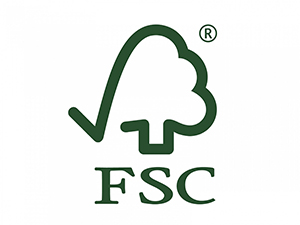The Meaning and Role of the Forest Stewardship Council (FSC)
Have you ever looked at the back of a greeting card and noticed a check-mark-and-tree-shaped symbol with the letters FSC, or seen the notation "FSC Certified," and wondered what it means and why is it important?
The initials FSC stands for the Forest Stewardship Council. It is an international, independent, member-driven, nonprofit organization dedicated to protecting forests around the world for the benefit of future generations. Made up of environmentalists, businesses and other interested parties, the organization was established in 1993, when an agreement to improve the practices of forestry management, preservation and maintenance failed at the 1992 Earth Summit. The U.S. chapter of the FSC was established in 1995.
Concerned over the loss of old-growth forests and other worldwide deforestation practices having a negative impact on the environment, the FSC founding members set out to establish an approach to responsible management of forests that was voluntary, responsible and market-based—one that would ensure the preservation of forests for future generations while still enabling the production of forest products to meet current needs.
Mission and Organization
The Forest Stewardship Council set out its vision in 10 Principles that establish standards for the responsible management of forests. These principles govern its members to follow socially beneficial, environmentally sustainable and economically sound practices to ensure the long-term, prosperous management of the forests worldwide. Although adherence to these standards is voluntary, members of the FSC recognize the value of maintaining the integrity of forests now and in the future.Since members of the Forest Stewardship Council have different reasons and interests in preserving forest lands, the FSC organization is divided into three divisions or "chambers" based on those interests—environmental, economic and social; members are assigned to a chamber accordingly.
The environmental chamber includes nonprofit and non-governmental organizations such as Greenpeace, The Sierra Club, World Wildlife Fund and National Wildlife Federation, as well as research, technical and academic institutions. The Economic Chamber includes retail and wholesale businesses that depend on forest products for their livelihood, as well as industry and trade associations and certification bodies. The social chamber includes indigenous people, labor unions and community-development organizations. Simply put, each chamber has an equal say or weight in voting on policy and decisions. Thus, no one area of interest outweighs any other in terms of voting power and decision-making authority.
FSC Certification
Based on its principles, the Forest Stewardship Council has a well-respected, rigorous and credible forest certification system. Within the certification program, there are two classifications of certification: Forest Management and Chain of Custody.The FSC's Forest Management certification ensures that a specific forest or area of a forest is managed according to the FSC's principle standards. The Chain of Custody certification ensures that from forest to end-user, the integrity of FSC-certified products is maintained down through the supply chain. Certified materials are identified and kept separated from non-certified products throughout the process.
Certification of forests and the products that come out of them are certified by independent, accredited third parties. This protects and assures the integrity of the system. Thus, when you see the FSC logo or indication that the wood, paper or other forest-based product is "FSC Certified," you can be assured that it originates from a responsibly managed forest.
The Importance of the FSC and Forest Preservation Why is the FSC and its mission important? There are a number of reasons:
- The trees in forests help to regulate our climate. Trees are the main system that cleans the air that we breathe; they take in the carbon from the atmosphere and put back oxygen. The rise in greenhouse gases in the atmosphere can be linked, in part, to the loss of forest coverage. Trees also help to filter our water.
- Forests are the habitat for the majority of wildlife creatures and plants on land. Their unique ecosystems support plant and animal life in an interdependent chain of living things—plants, insects and wildlife. If the forest disappears or isn't sustainably managed, all the other plants and animals that exist within it or depend on it for what it produces will be negatively affected.
- Forests provide many of the products we use and depend on every day—such as the wood for building products and furniture; and paper for greeting cards, books, product packaging, toilet tissue and much more.
- Many old-growth trees and forests are protected, as are rare, threatened or endangered species.
- Deforestation or conversion of natural forests to plantations of a single species of tree is prohibited.
- The amount of clearcutting in a particular area is limited to maintain and protect the natural ecosystem.
- The rights of indigenous peoples in forest areas are protected.
- The use of toxic or hazardous pesticides is restricted.
Forests currently cover some 30 percent of land overall. However, we are losing approximately 30 million acres of forest each year, much to development, according to the FSC. Through the efforts of the FSC and its membership, more that 380 million acres of forests worldwide are certified under the FSC system, with more than 150 million acres in the U.S. and Canada. The organization continues to work diligently to certify and protect more forest acreage for the good of current and future generations.




